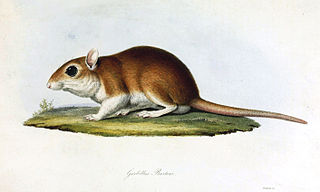
Burton's gerbil is distributed mainly in Darfur, Sudan. Less than 250 individuals of this species of rodent are thought to persist in the wild. It may have been named after Edward Burton, who had the gerbil in his menagerie, obtained from Darfur and described by Frédéric Cuvier.

Calosoma sycophanta, the forest caterpillar hunter, is a species of ground beetle belonging to the family Carabidae.
Burton's vlei rat is a species of rodent in the family Muridae. It is found only in Cameroon. Its natural habitats are subtropical or tropical high-altitude shrubland, subtropical or tropical high-altitude grassland, and swamps. It is threatened by habitat loss.

Astatotilapia burtoni is a species of fish in the family Cichlidae.

Charles A. Alluaud was a French entomologist.

Burton's legless lizard is a species of lizard in the family Pygopodidae. The species lacks forelegs and has only rudimentary hind legs. Pygopodid lizards are also referred to as "legless lizards", "flap-footed lizards" and "snake-lizards". This species is native to Australia and Papua New Guinea.

Calosoma is a genus of large ground beetles that occur primarily throughout the Northern Hemisphere, and are referred to as caterpillar hunters or caterpillar searchers. Many of the 167 species are largely or entirely black, but some have bright metallic coloration. They produce a foul-smelling spray from glands near the tip of the abdomen. They are recognizable due to their large thorax, which is almost the size of their abdomen and much wider than their head.
Louis Beethoven Prout (1864–1943) was an English entomologist and musicologist.
Hexagonia is a genus of ground beetles in the family Carabidae. There are more than 40 described species in Hexagonia, found in Asia and Africa.

Pterostichinae is a subfamily of ground beetles. It belongs to the advanced harpaline assemblage, and if these are circumscribed sensu lato as a single subfamily, Pterostichinae are downranked to a tribe Pterostichini. However, as the former Pterostichitae supertribe of the Harpalinae as loosely circumscribed does seem to constitute a lineage rather distinct from Harpalus, its core group is here considered to be the present subfamily and the Harpalinae are defined more narrowly.

Eucamptognathus is a genus of beetles in the family Carabidae, containing the following species:
Eudromus is a genus of beetles in the family Carabidae, containing the following species:

Scaritinae is a large subfamily of beetles in the family Carabidae, containing more than 2400 species in over 140 genera. They are found worldwide.
Pachydesus is a genus of beetles in the family Carabidae, containing the following species:
Calosoma bastardi is a species of ground beetle in the subfamily of Carabinae. It was described by Alluaud in 1925.
Calosoma masaicus is a species of ground beetle in the subfamily of Carabinae. It was described by Alluaud in 1912.
Calosoma monticola is a species of ground beetle in the subfamily of Carabinae. It was described by Casey in 1913.
Eucamptognathus diacritus is a species of ground beetle in the subfamily Pterostichinae. It was described by Alluaud in 1913.
Opharus calosoma is a moth of the family Erebidae. It was described by Harrison Gray Dyar Jr. in 1913. It is found in Mexico.








